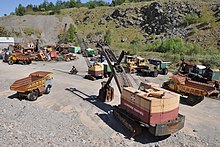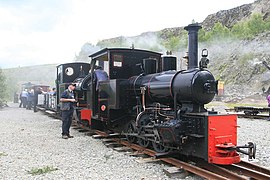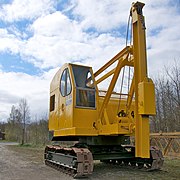Threlkeld Quarry and Mining Museum
| Threlkeld Quarry & Mining Museum | |
|---|---|
|
Hunslet diesel locomotive with passenger train
| |
| Route length: | 0.8 km |
| Gauge : | 610 mm ( 2 foot track ) |

The Threlkeld Quarry & Mining Museum is a quarry and mining museum in Threlkeld east of Keswick in the Lake District in Cumbria , UK .
Mine
The Threlkeld quarry was opened in 1870 to mine granite as ballast for the construction of the Penrith – Keswick railway line . Later, the granite was the dam of Thirlmere , as track construction gravel for the rail line Crewe-Carlisle , the street paving, as a curb used and for construction of houses. The mine closed in 1982 and has since been home to the Threlkeld Quarry & Mining Museum, which is run by a number of volunteers and salaried employees.
railroad

The track of the field railway with a track width of 610 mm (2 feet ) has been relocated and offers visitors safe access to the pit to view the quarries. Some locomotives are used regularly, others are on display in the upper engine shed.
Sir Tom
The Sir Tom steam locomotive was built in 1926 by WG Bagnall in Stafford and named after Sir Tom Callender , the founder of British Insulated Callender's Cables (BICC). The two-axle saddle tank locomotive was used industrially at BICC in Kent until 1968. After that, it was parked for 30 years until it came to Threlkeld in 2001, was overhauled there and has been used for passenger transport since 2010.
Hunslet
The 50 hp two-axle Hunslet diesel locomotive was built in 1945 and used by the National Coal Board underground in South Yorkshire until the coal mine was closed. Afterwards it was equipped with air brakes so that it can be used regularly for passenger traffic.
Ruston
The Ruston 48 DL diesel locomotive was built in 1947 and used in the Royal Navy Armaments Depot at Broughton Nook, near Cockermouth . It was procured when the depot was closed in 1994 and re-gauged from 762 mm (2½ feet) to 610 mm (2 feet) and fitted with air brakes.
stollen
The museum has a tunnel, in cooperation with the Cumbria Amenity Trust Mining History Society and some volunteers drilled was. For many visitors, a guided tour through the tunnel is the highlight of their visit. Tours are dependent on the weather and the availability of guides.
museum
The museum has been in operation since 1991 and is constantly expanding. It is open every day from Easter to October.
Open air exhibition
The outdoor area features the largest collection of historic excavators in Great Britain with 70 vehicles, many of which are ready for use. These are demonstrated on working weekends, usually in May and September. The oldest steam excavator in the collection is a Ruston & Proctor from 1909. It was refurbished with funds from the Heritage Lottery Fund and returned to service in May 2015.
Hudswell Clarke steam locomotive
Ruston pile driver
Aveling-Barford dump truck
Ever since the grazing of sheep blocked by a fence, has in the nutrient-rich granite a habitat with cornflower , knapweed , Exceptional Hornklee , arable widow flowers and wild orchids and Common Blue butterflies and little fire butterflies trained.
You can try your luck as a gold washer by a stream.
Web links
Individual evidence
- ↑ Chris Allen: Threlkeld Quarry & Mine Museum. The geographer.
- ^ Threlkeld Quarry & Mining Museum - The railway.
- ^ Threlkeld Quarry & Mining Museum.
- ^ Threlkeld Quarry and Mining Museum. ( Memento of the original from March 4, 2016 in the Internet Archive ) Info: The archive link was inserted automatically and has not yet been checked. Please check the original and archive link according to the instructions and then remove this notice.
- ↑ Tony Greenbank: An abandoned industrial site hiding a wildlife haven. The Guardian, Aug. 10, 2015.
Coordinates: 54 ° 36 '47.1 " N , 3 ° 2' 49.5" W.







